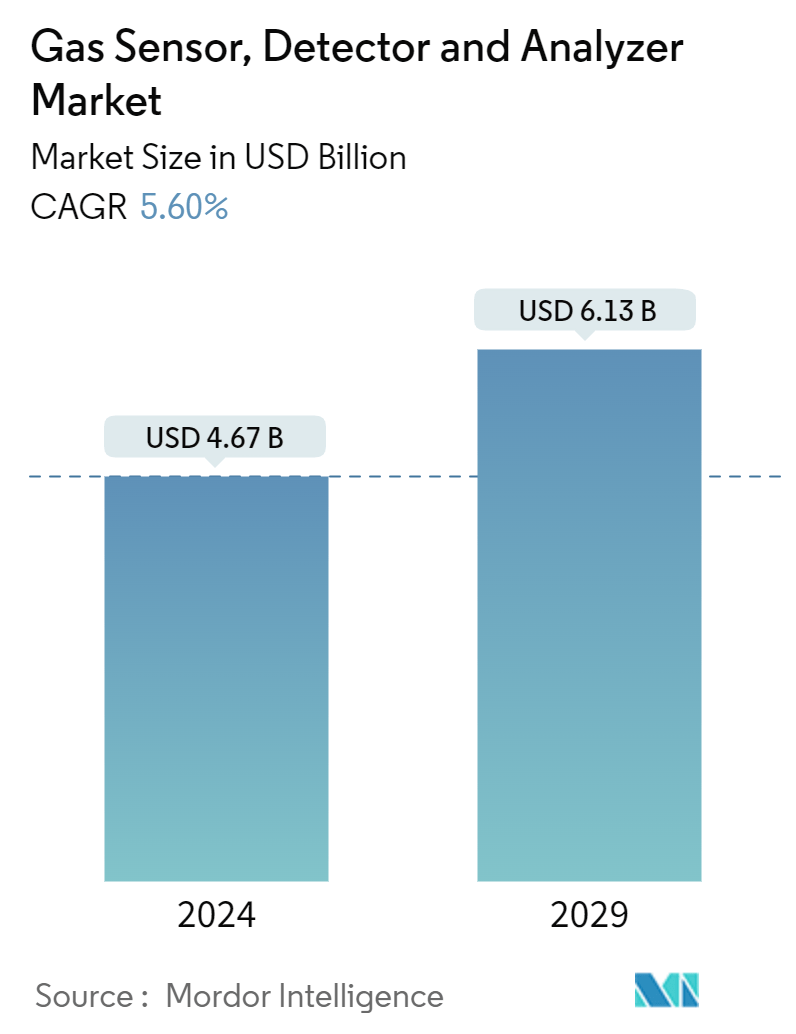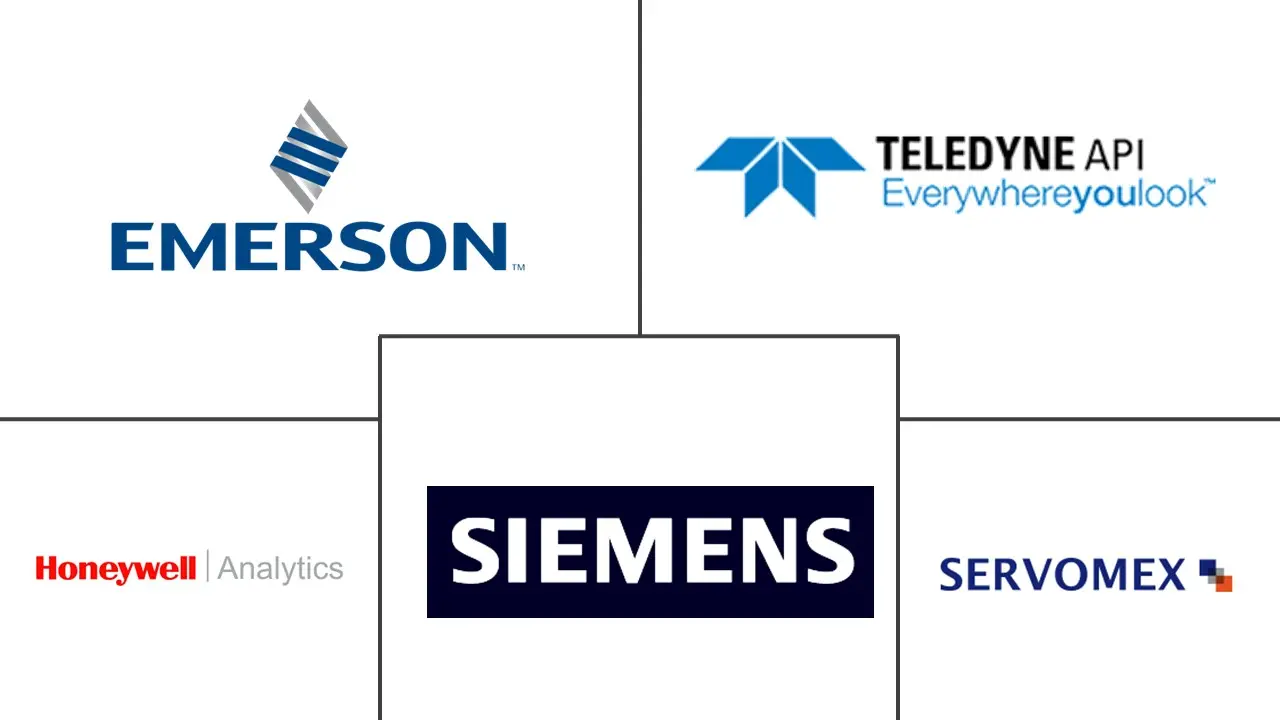Market Size of Gas Sensor, Detector And Analyzer Industry

| Study Period | 2019 - 2029 |
| Market Size (2024) | USD 4.67 Billion |
| Market Size (2029) | USD 6.13 Billion |
| CAGR (2024 - 2029) | 5.60 % |
| Fastest Growing Market | Asia Pacific |
| Largest Market | Asia Pacific |
| Market Concentration | Low |
Major Players
*Disclaimer: Major Players sorted in no particular order |
Gas Sensor, Detector, and Analyzer Market Analysis
The Gas Sensor, Detector And Analyzer Market size is estimated at USD 4.67 billion in 2024, and is expected to reach USD 6.13 billion by 2029, growing at a CAGR of 5.60% during the forecast period (2024-2029).
Gas sensors are chemical sensors that can measure the concentration of a constituent gas in its vicinity. These sensors embrace different techniques for quantifying a medium's exact amount of gas. A gas detector measures and indicates the concentration of certain gases in the air via other technologies. These are characterized by the type of gases they can detect in the environment. Gas analyzers find applications across safety instruments used in multiple end-user industries to maintain adequate safety in the workplace.
- The global demand for gas analyzers has been boosted by an increase in shale gas and tight oil discoveries since these resources are utilized to stop corrosion in the infrastructure of natural gas pipelines. The use of gas analyzers has also been enforced in several industrial settings by government law and the enforcement of occupational health and safety rules. The growing public consciousness of the dangers of gas leaks and emissions contributed to the increased adoption of gas analyzers. Manufacturers are integrating gas analyzers with mobile phones and other wireless devices to offer real-time monitoring, remote control, and data backup.
- Gas leaks and other unintentional contamination can result in explosive consequences, physical harm, and fire risk. In confined spaces, numerous hazardous gases can even asphyxiate workers in the vicinity by displacing oxygen, which results in death. These outcomes jeopardize employee safety and the safety of equipment and property.
- Handheld gas detection tools keep personnel safe by monitoring a user's breathing zone while stationary and moving. These devices are critical in many situations where gas risks may exist. It is essential to monitor the air for oxygen, combustibles, and poisonous gases to ensure the safety of all people. Handheld gas detectors include built-in sirens that alert workers to potentially hazardous situations within an application, such as a confined space. When an alert is triggered, a large, easy-to-read LCD verifies the concentration of dangerous gas or gases.
- The production costs for gas sensors and detectors have steadily risen due to recent technological changes. While the market incumbents have been able to adapt to these changes, new entrants and mid-range manufacturers face considerable challenges.
- With the onset of COVID-19, multiple end-user industries in the market studied have been affected by reduced operations, temporary factory closures, etc. For instance, in the renewable energy industry, significant concerns revolve around global supply chains, which are considerably slowing down production, thus, aiming at reduced spending for new measurement systems and sensors. The detection and monitoring of hydrogen sulfide (H2S) and carbon dioxide (CO2) is pertinent in natural gas processing, creating significant demand for gas analyzers.
Gas Sensor, Detector, and Analyzer Industry Segmentation
Gas analyzers, sensors, and detectors are safety devices used in commercial, medical, industrial, and other industries. These devices continuously analyze and monitor the concentration of gases in different end-user industries, and thus, provide life safety and help avoid fire breakouts.
The Gas Sensor, Detector, and Analyzer Market is Segmented into Gas Analyzers (Technology (Electrochemical, Paramagnetic, Zirconia, Non-disruptive IR), End-user Industries (Oil & Gas, Chemicals & Petrochemicals, Water & Wastewater, Pharmaceuticals), Geography (North America, Europe, Asia Pacific, Latin America, Middle East, and Africa)), Gas Sensors (Type (Toxic (Electrochemical, Semiconductor, Photoionization), Combustible (Catalytic, Infrared), End-user Industry (Oil & Gas, Chemicals & Petrochemicals, Water & Wastewater, Metal & Mining, Utilities), Geography (North America, Europe, Asia Pacific, Latin America, Middle East, and Africa)), Gas Detectors (Communication Type (Wired, Wireless), Type of Detector (Fixed, Portable), End-user Industry (Oil & Gas, Chemicals & Petrochemicals, Water & Wastewater, Metal & Mining, Utilities), Geography (North America, Europe, Asia Pacific, Latin America, Middle East, and Africa)). The market sizes and forecasts are provided in terms of value in USD for all the above segments.
| Gas Analyzers | |||||||
| |||||||
| |||||||
|
| Gas Sensor | |||||||||||
| |||||||||||
| |||||||||||
|
| Gas Detectors | ||||||||
| ||||||||
| ||||||||
| ||||||||
|
Gas Sensor, Detector And Analyzer Market Size Summary
The gas sensor, detector, and analyzer market is poised for significant growth over the forecast period, driven by increasing demand across various industries. These devices play a crucial role in measuring and monitoring gas concentrations, ensuring safety and compliance in environments such as oil and gas, chemical processing, and renewable energy sectors. The market is characterized by the integration of advanced technologies, including mobile and wireless capabilities, to enhance real-time monitoring and data management. The rising awareness of gas leak hazards and stringent regulatory frameworks are further propelling the adoption of these technologies, as they are essential for maintaining workplace safety and preventing costly incidents.
The market landscape is competitive and fragmented, with numerous players striving to innovate and expand their offerings. Key regions such as Asia Pacific are witnessing rapid growth due to industrialization and increased investments in infrastructure projects. The region's adherence to international safety standards and government initiatives, such as smart city developments, are expected to drive demand for gas sensors and detectors. Companies are actively engaging in strategic partnerships, mergers, and technological advancements to strengthen their market position. The ongoing development of new refineries and natural gas projects globally is anticipated to sustain the demand for gas analyzers, further contributing to market expansion.
Gas Sensor, Detector And Analyzer Market Size - Table of Contents
-
1. MARKET INSIGHTS
-
1.1 Market Overview
-
1.2 Industry Attractiveness - Porter's Five Forces Analysis
-
1.2.1 Bargaining Power of Suppliers
-
1.2.2 Bargaining Power of Buyers
-
1.2.3 Threat of New Entrants
-
1.2.4 Threat of Substitutes
-
1.2.5 Intensity of Competitive Rivalry
-
-
1.3 Industry Value Chain Analysis
-
1.4 An Assessment of the Impact of COVID-19 on the Industry
-
-
2. MARKET SEGMENTATION
-
2.1 Gas Analyzers
-
2.1.1 Technology
-
2.1.1.1 Electrochemical
-
2.1.1.2 Paramagnetic
-
2.1.1.3 Zirconia
-
2.1.1.4 Non-disruptive IR
-
-
2.1.2 End-user Industry
-
2.1.2.1 Oil and Gas
-
2.1.2.2 Chemicals and Petrochemicals
-
2.1.2.3 Water and Wastewater
-
2.1.2.4 Pharmaceuticals
-
2.1.2.5 Other End-user Industries
-
-
2.1.3 Geography
-
2.1.3.1 North America
-
2.1.3.2 Europe
-
2.1.3.3 Asia-Pacific
-
2.1.3.4 Latin America
-
2.1.3.5 Middle-East and Africa
-
-
-
2.2 Gas Sensor
-
2.2.1 Type
-
2.2.1.1 Toxic
-
2.2.1.1.1 Electrochemical
-
2.2.1.1.2 Semiconductor
-
2.2.1.1.3 Photoionization
-
-
2.2.1.2 Combustible
-
2.2.1.2.1 Catalytic
-
2.2.1.2.2 Infrared
-
-
-
2.2.2 End-user Industry
-
2.2.2.1 Oil and Gas
-
2.2.2.2 Chemicals and Petrochemicals
-
2.2.2.3 Water and Wastewater
-
2.2.2.4 Metal and Mining
-
2.2.2.5 Utilities
-
2.2.2.6 Other End-user Industries
-
-
2.2.3 Geography
-
2.2.3.1 North America
-
2.2.3.2 Europe
-
2.2.3.3 Asia-Pacific
-
2.2.3.4 Latin America
-
2.2.3.5 Middle-East and Africa
-
-
-
2.3 Gas Detectors
-
2.3.1 Communication Type
-
2.3.1.1 Wired
-
2.3.1.2 Wireless
-
-
2.3.2 Type of Detector
-
2.3.2.1 Fixed
-
2.3.2.2 Portable
-
-
2.3.3 End-user Industry
-
2.3.3.1 Oil and Gas
-
2.3.3.2 Chemicals and Petrochemicals
-
2.3.3.3 Water and Wastewater
-
2.3.3.4 Metal and Mining
-
2.3.3.5 Utilities
-
2.3.3.6 Other End-user Industries
-
-
2.3.4 Geography
-
2.3.4.1 North America
-
2.3.4.2 Europe
-
2.3.4.3 Asia-Pacific
-
2.3.4.4 Latin America
-
2.3.4.5 Middle-East and Africa
-
-
-
Gas Sensor, Detector And Analyzer Market Size FAQs
How big is the Gas Sensor, Detector and Analyzer Market?
The Gas Sensor, Detector and Analyzer Market size is expected to reach USD 4.67 billion in 2024 and grow at a CAGR of 5.60% to reach USD 6.13 billion by 2029.
What is the current Gas Sensor, Detector and Analyzer Market size?
In 2024, the Gas Sensor, Detector and Analyzer Market size is expected to reach USD 4.67 billion.

